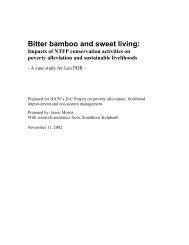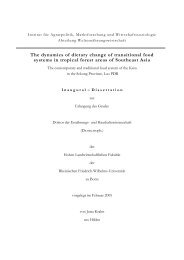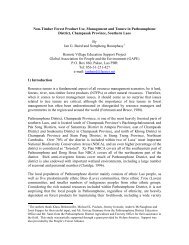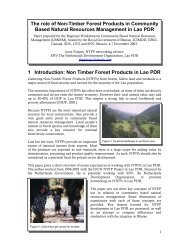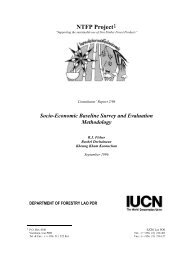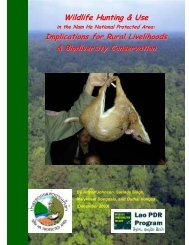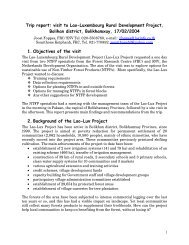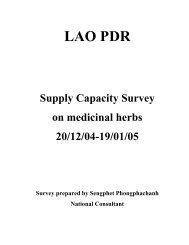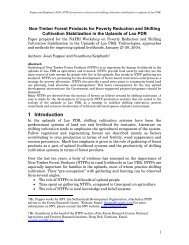You also want an ePaper? Increase the reach of your titles
YUMPU automatically turns print PDFs into web optimized ePapers that Google loves.
3 PROMINENT NTFP’S OF NAKAI PLATEAU<br />
3.1 Listing of NTFP’s by groups of villagers<br />
Villagers were asked to list all products which they gather from the forest. A complete list of<br />
all NTFP’s recorded in this study is given in Annex 1: “NTFP List”. A total number of 306<br />
NTFP species were recorded during this short survey (Table 1).<br />
Table 1: Main categories of NTFP’s found <strong>on</strong> the <strong>Nakai</strong> plateau,<br />
identified by villagers in 5 villages visited, March 1997.<br />
Category No of species Category No of species<br />
A: Food Products 223 B: N<strong>on</strong>-food Products 67<br />
1 rattan/bamboo shoots 17 1 rattans 7<br />
2 tubers 7 2 bamboos 8<br />
3 vegetables 40 3 grasses, fibres 9<br />
4 fruits 51 4 medicines 43<br />
5 mushrooms 9<br />
6 mammals 31 C: Sellable Products 16<br />
7 birds 24<br />
8 reptiles 13 TOTAL 306<br />
9 fishes 28<br />
10 molluscs 3<br />
The most prominent NTFP’s will be described in more detail in the next paragraphs.<br />
3.2 Main products for local use<br />
Rattan and bamboo shoots, cooked or eaten raw, are the most important side dish to rice <strong>on</strong><br />
the daily menu. The two most comm<strong>on</strong> species are “boun” (Daem<strong>on</strong>orops schmidtiana), a<br />
medium sized rattan, and “san” (Raphis sp.) a small palm tree.<br />
Fish and other water animals like frogs, shrimps, soft-shelled turtles, crabs and molluscs are<br />
probably the most important source of protein in the diet of villagers <strong>on</strong> the <strong>Nakai</strong> plateau, as<br />
in most of Lao PDR. There are over 85 species of fish in the upper Nam Theun regi<strong>on</strong><br />
(Roberts, 1996; Kottelat, 1996). In our survey, villagers menti<strong>on</strong>ed 28 species.<br />
Wildlife is a more important source of protein than livestock for most villages in the upper<br />
Nam Theun. Some 31 mammal species, 24 bird species and 13 reptile species were recorded<br />
as regularly eaten (see appendix 1). During our fieldwork, freshly hunted animals were<br />
regularly offered for sale to the team: we saw junglefowl (Gallus gallus), mousedeer<br />
(Tragulus javanicus), red squirrels (Calliosciurus finlays<strong>on</strong>i), brown hornbill (Ptilolaemus<br />
tickelii).<br />
Vegetables: Some 40 types of leaves from trees, shrubs and herbs are eaten fresh or cooked.<br />
These are comm<strong>on</strong>ly referred to as “phak”. Tubers, “man”,”koy” (Dioscorea spp.) are eaten<br />
as a susbstitute for rice in times of hunger. Mushrooms, “hed” are important in the rainy<br />
seas<strong>on</strong>. Various flowers, “dok” and forest fruits “mak” (51 species) are also gathered and<br />
eaten.



